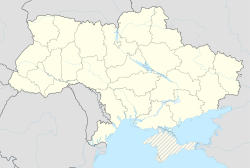Çufut Qale
|
Çufut Qale Чуфут-Кале |
|
|---|---|
| Historic settlement | |

Çufut Qale cave city
|
|
| Coordinates: 44°44′28″N 33°55′28″E / 44.74111°N 33.92444°ECoordinates: 44°44′28″N 33°55′28″E / 44.74111°N 33.92444°E | |
| Country | Russia/Ukraine |
| Region |
|
| Raion | Bakhchysaray Raion |
| Established | 6th - 10th century |
| Time zone | MSK (UTC+4) |
Chufut-Kale (Crimean Tatar pronunciation: [tʃuˈfut qaˈle]; Russian and Ukrainian: Чуфут-Кале - Chufut-Kale; Crimean Tatar: Çufut Qale; Karaim: Къале - Qale) is a medieval city-fortress in the Crimean Mountains that now lies in ruins. It is a national monument of Crimean Karaites culture just 3 km (1.9 mi) east of Bakhchisaray.
Its name is Crimean Tatar and Turkish for "Jewish Fortress" (çufut/çıfıt - Jew, qale/kale - fortress), while Crimean Karaites refer to it simply as "Fortress", considering the place as historical center for the Crimean Karaite community. In the Middle Ages the fortress was known as Qırq Yer (Place of Forty) and as Karaites to which sect the greater part of its inhabitants belong, Sela' ha-Yehudim (The Rock of the Jews).
Researchers are not unanimous as to the time of the town’s appearance. The town was probably a fortified settlement in the 5th or 6th century οn the periphery of the Byzantine Empire. Others are of the opinion that the fortified settlement appeared in the 10th-11th centuries. During the early period of the town’s history, it was mainly populated by Alans, the most powerful of a late Sarmatian tribes of Iranian descent. They began penetrating the Crimea from the 2nd century AD. Settling down in the mountainous Crimea, the Alans adopted Christianity. In written sources the cave town is mentioned in the 13th century under the name of Kyrk-Or (Forty Fortifications). This name lasted until the mid-17th century. In 1299 the Tatar horde of Emir Nogai raided the Crimean peninsula. Kyrk-Or was among the sacked towns. Having seized the town, the Tatars quartered their garrison in it. At the turn of the 15th century, Tatars settled Karaite craftsmen in front of the eastern line of fortifications and built a second defensive wall to protect their settlement, and thus a new part of the town appeared.
...
Wikipedia

